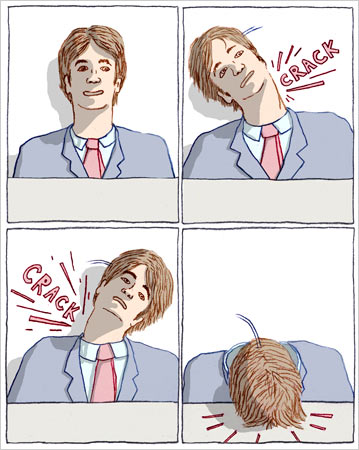
Cervical instability after the increase, vertebral bone hyperplasia, constitutes a spinal cord stimulation and repression.
1. Intervertebral disc is generally believed that the first disc is the body most likely to occur with age regression to change the organization, and the strain, trauma, a significant relationship. the normal intervertebral disc water content 80%, 65% water annulus, age increases, the water content decreased, and thus gradually loses its elasticity and toughness. When the disc rupture or prolapse, the water content of less disc weakness, weight loss support the role of disc space narrowing, bending the spine before and after the dislocation of vertebrae, resulting in instability between vertebrae. annulus outside the layer of nerve root branch points out of the sinus after the vertebral nerve distribution, when the annulus under abnormal pressure, such as swelling, dislocation, etc. can stimulate nerves and vertebral sinus reflex to the rear support, causing neck and shoulder pain, muscle cramps and other symptoms items. in normal saline injected into the disc does not produce symptoms, and the degeneration of the intervertebral disc into the water immediately produce the typical symptoms of neck and shoulder pain, neck pain and disc disease seen closely. ruptured disc prolapse can be to the rear of spinal cord compression , causing symptoms. This is a common cause of cervical spondylosis.
2. vertebral osteophyte formation of vertebral disc degeneration due to the first section of vertebral instability. and after the vertebrae instability , the upper and lower vertebrae of the vertebrae unusual activity, instantaneous center of rotation changes, the stress increased vertebral body, vertebral compensatory hypertrophy occurred, mainly around the edge of the vertebral hyperostosis stress concentration points. due to the long times osteophyte formation of stress tend to change the texture. osteophyte formation can also be ligament – intervertebral disc space of granulation tissue in the repeated trauma, the plane of the strain stimulus, ossification or calcification of the growing hard.
3. facet joints are mostly secondary changes. As the disc changes in morphology and function, cervical stress redistribution occurs, the direction and size of the articular surface pressure changes are small changes in both joints occur. first Joint capsule suffered increased traction, producing congestion and edema and hyperplasia, the second is the degeneration of articular cartilage damage, and then spread to the cartilage, the formation of traumatic arthritis. advanced joint space narrowing and lead to proliferation of small joints, intervertebral foramen and the anteroposterior diameter of the upper and lower diameter were narrowed, can stimulate the spinal nerve root and vertebral meningeal sinus nerve to the recurrent branch of clinical symptoms.
4. yellow ligament degeneration of the ligamentum flavum of cervical vertebrae in a stable when the generation of abnormal compensation for the data. early ligamentous laxity, post hyperplasia, hypertrophy, calcification or ossification can be. hyperplasia of the ligamentum flavum can be broke into the spinal canal, spinal cord compression constituted.
5. hyperplasia hook Luschka joint vertebral joints are not born, it is in the process of growth and degeneration, due to the biomechanical needs of the neck formation. but hook taper joint can stimulate excessive proliferation of the nerve root.
6. anterior longitudinal ligament and posterior longitudinal ligament of the two ligaments the stability of the cervical spine protection. In reaction after trauma or strain hyperplasia and hypertrophy, and even calcification and ossification. Recent studies show that individual patients mainly for the post early OPLL longitudinal ligament hypertrophy.
7. nuchal ligament nuchal ligament and neck muscles and neck muscles in the role of mechanical equilibrium of the cervical spine. With age, the neck reduced neuromuscular response, muscle strain and spasms can affect cervical flexion, flexion of the long-term adverse speeds and other bony structures disc degeneration.
(d) neck inflammation
acute and neck chronic infection, inflammation can directly stimulate nearby muscles and ligaments, causing ligament relaxation, reduce muscle tension, internal and external imbalance vertebrae, damage to its stability, accelerate and promote the development and progression of degeneration.
congenital malformations of the cervical spine of the major impact of disease in the following two aspects: first, the change of stress; the second is to stimulate nerves and blood vessels and oppression.
1. congenital fusion of the cervical vertebrae and neck 3,4 2,3 common, followed by neck 4,5, mostly for double single. as vertebral fusion between two vertebrae of the vertebral the activity between RA Shibi transferred to adjacent the intervertebral joints. Shide stress concentration adjacent disc degeneration aggravated injury or even arthritis. In addition to incomplete congenital vertebral section sub-section outside the clinic on the common to the fusion surgery adjacent segment disc degeneration increased, resulting in clinical symptoms and signs.
2. spinous vertebral deformity mainly affects the stability of the external structure, and thus indirectly form factors of cervical disease.
3. cervical rib and hypertrophy of the seventh cervical transverse process while not causing both abnormal cervical disease, but when the lower trunk of brachial plexus stimulation, there may be neck and upper extremity symptoms and discomfort, must be differentiated from cervical spondylosis .
(f) developmental spinal stenosis
can often be seen clinically, and some serious cervical spine degeneration, osteophyte proliferation significantly, but not the disease, because patients with cervical sagittal diameter is wider. degeneration of some patients is not serious, but very early symptoms. you can see from the image data, the actual cervical sagittal diameter determines the size of the symptom or not. spinal stenosis easily subjected to traumatic spinal cord injury, even minor trauma is also easy to disease, and severe symptoms. canal is not only easy to big to disease, and the symptoms are mild.